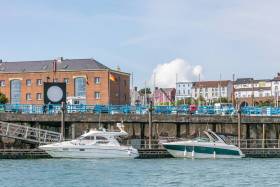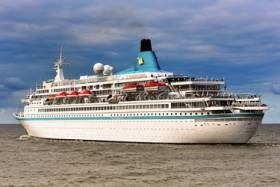Displaying items by tag: Milford Marina
#coastalnotes - The Port of Milford Haven, south Wales has completed further improvements to its lock gates at Milford Marina. The works by the port authority have created a more flexible and faster access arrangement for the marina and its dock customers.
The natural waterway of Milford Haven in Pembrokeshire is where the port handles oil and gas and as such is widely recognised in the industry as the energy capital of the UK.
As for the marina, in 2014 an additional set of mitre gates, known as the Samson Gates, were installed at the site which provided quicker and more frequent access, as well as additional support, for the existing gates. In the 2018 programme of maintenance, alterations have been carried out on these gates resulting in a much smoother and more efficient operation.
Marina customers will remember one of the sets of mitre lock gates sustaining damage during the extreme weather conditions during Storm Ophelia. A major recovery system was immediately put in place to ensure minimal disruption to customers, with a temporary drive system installed. Since then, the Port has been working collaboratively with Royal Haskoning and Pressure Design - commissioning them to undertake a detailed study and to design a more modern and robust system.
The upgraded operating system has shortened the lock time to five minutes and enabled the lock gates to operate 24/7 with the tide. Also, both sets of gates now allow pedestrians to cross during most states of the tide; the only time the crossing isn’t available is during ‘freeflow’. This is operated by a traffic light system.
Melanie Durney, Marina and Docks Manager, commented: “We recognise the impact that this had on our customers, and are grateful for their patience. The damage we sustained from Storm Ophelia was unforeseen, but we have used this event to undertake further improvement works. We are proud to be able to offer a more flexible and extended locking programme, and improve the experience for our marina and dock customers.”
#CruiseLiners - A cruiseship that is due to Dublin Port tomorrow is at the time of writing entering the deepwater south Wales port of Milford Haven this afternoon.
The German cruiseship Albatros will become the first caller in Milford Haven this year. The port is expecting a busy cruise season with a further two callers scheduled this month bringing over 1,000 passengers to the area, and an additional six calls planned between July and September.
Albatros is notable for the bright turquoise funnel rising above the white ship. The cruiseship embarked passengers in Bremerhaven, Germany for a cruise around Britain and arrives at Milford Haven this morning and is to anchore at Milford Shelf (just outside Milford Marina) until 8pm.
The next port of call as alluded is Dublin Port. Afloat adds that the elegant first-generation cruiseship operated by Pheonix Reisen has been allocated a berth at Ocean Pier. The 28,000 gross tonnage cruiseship has called to the capital before and other Irish Sea ports having entered service in 1973.
Returning to the team at Milford Waterfront, including port staff, local businesses and entertainers will be on the quayside to extend a warm Welsh welcome as visitors come ashore.
On Sunday, ‘Silver Cloud’ will call at Pembroke Port (the ferryport is also located in the Haven). Shortly after that, on 20th May, ‘MV Seabourn Quest’ will call into Milford Haven. This is a luxury cruiseship offering award-winning dining experiences and high end décor. The call willl be part of a 15-day tour of the British Isles and Iceland.
For passengers choosing to stay in Milford Haven, there is an expanding range of things to do. From a visit to Milford Museum, a bite to eat at one of many cafes and restaurents in Milford Waterfront (see related development story) or a spot of retail therapy along the promenade and in the town centre.






























































